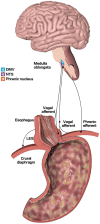Current Advancement on the Dynamic Mechanism of Gastroesophageal Reflux Disease
- PMID: 34803489
- PMCID: PMC8579455
- DOI: 10.7150/ijbs.65066
Current Advancement on the Dynamic Mechanism of Gastroesophageal Reflux Disease
Abstract
Gastroesophageal reflux disease (GERD) is a common clinical disease associated with upper gastrointestinal motility disorders. Recently, with improvements in living standards and changes in lifestyle and dietary habits, the incidence of GERD has been increasing yearly. However, the mechanism of GERD has not been fully elucidated due to its complex pathogenesis, and this had led to unsatisfactory therapeutic outcomes. Currently, the occurrence and development of GERD involve multiple factors. Its pathogenesis is mainly thought to be related to factors, such as lower esophageal sphincter pressure, transient lower esophageal sphincter relaxation, crural diaphragmatic dysfunction, hiatus hernia, and impaired esophageal clearance. Therefore, explaining the pathogenesis of GERD more clearly and systematically, exploring potential and effective therapeutic targets, and choosing the best treatment methods have gradually become the focus of scholars' attention. Herein, we reviewed current advancements in the dynamic mechanism of GERD to better counsel patients on possible treatment options.
Keywords: advancement; anti-reflux barrier disruption; dynamic mechanism; esophageal clearance impaired; gastroesophageal reflux disease.
© The author(s).
Conflict of interest statement
Competing Interests: The authors have declared that no competing interest exists.
Figures





Similar articles
-
The role of hiatus hernia in GERD.Yale J Biol Med. 1999 Mar-Jun;72(2-3):101-11. Yale J Biol Med. 1999. PMID: 10780571 Free PMC article. Review.
-
Gastroesophageal reflux disease: an update on management.J Clin Gastroenterol. 1990;12 Suppl 2:S21-8. J Clin Gastroenterol. 1990. PMID: 1978843 Review.
-
Evolution in the treatment of gastroesophageal reflux disease over the last century: from a crural-centered to a lower esophageal sphincter-centered approach and back.Dis Esophagus. 2023 Jun 15;36(Supplement_1):doac084. doi: 10.1093/dote/doac084. Dis Esophagus. 2023. PMID: 37317929 Review.
-
[Roles of diaphragmatic crural barrier and esophageal body clearance in patients with gastroesophageal reflux disease].Zhongguo Yi Xue Ke Xue Yuan Xue Bao. 2002 Jun;24(3):289-93. Zhongguo Yi Xue Ke Xue Yuan Xue Bao. 2002. PMID: 12905637 Chinese.
-
Esophageal Motor Dysfunctions in Gastroesophageal Reflux Disease and Therapeutic Perspectives.J Neurogastroenterol Motil. 2019 Oct 30;25(4):499-507. doi: 10.5056/jnm19081. J Neurogastroenterol Motil. 2019. PMID: 31587540 Free PMC article. Review.
Cited by
-
Causal relationship analysis between 35 blood/urine metabolites and gastroesophageal reflux disease: A Mendelian randomization combined meta-analysis study.Medicine (Baltimore). 2024 Aug 9;103(32):e39248. doi: 10.1097/MD.0000000000039248. Medicine (Baltimore). 2024. PMID: 39121258 Free PMC article.
-
Prevalence, General and Periodontal Risk Factors of Gastroesophageal Reflux Disease in China.J Inflamm Res. 2023 Jan 17;16:235-244. doi: 10.2147/JIR.S395777. eCollection 2023. J Inflamm Res. 2023. PMID: 36691403 Free PMC article.
-
The comparison of post-proximal gastrectomy digestive tract reconstruction methods.BMC Surg. 2025 Jan 3;25(1):1. doi: 10.1186/s12893-024-02748-x. BMC Surg. 2025. PMID: 39754095 Free PMC article.
-
Effect of Fermented Soybean (FSB) Supplementation on Gastroesophageal Reflux Disease (GERD).Nutrients. 2024 Aug 20;16(16):2779. doi: 10.3390/nu16162779. Nutrients. 2024. PMID: 39203915 Free PMC article. Clinical Trial.
-
Causal associations between gastroesophageal reflux disease and essential hypertension: A bidirectional Mendelian randomization study.World J Clin Cases. 2024 Feb 16;12(5):880-890. doi: 10.12998/wjcc.v12.i5.880. World J Clin Cases. 2024. PMID: 38414595 Free PMC article.
References
-
- Maret-Ouda J, Markar SR, Lagergren J. Gastroesophageal Reflux Disease: A Review. JAMA. 2020;324:2536–47. - PubMed
-
- Vakil N, van Zanten SV, Kahrilas P, Dent J, Jones R, Global Consensus G. The Montreal definition and classification of gastroesophageal reflux disease: a global evidence-based consensus. Am J Gastroenterol. 2006;101:1900–20. quiz 43. - PubMed
-
- Mehta RS, Staller K, Chan AT. Review of Gastroesophageal Reflux Disease. JAMA. 2021;325:1472. - PubMed
-
- Katzka DA, Kahrilas PJ. Advances in the diagnosis and management of gastroesophageal reflux disease. BMJ. 2020;371:m3786. - PubMed
Publication types
MeSH terms
LinkOut - more resources
Full Text Sources
Medical

